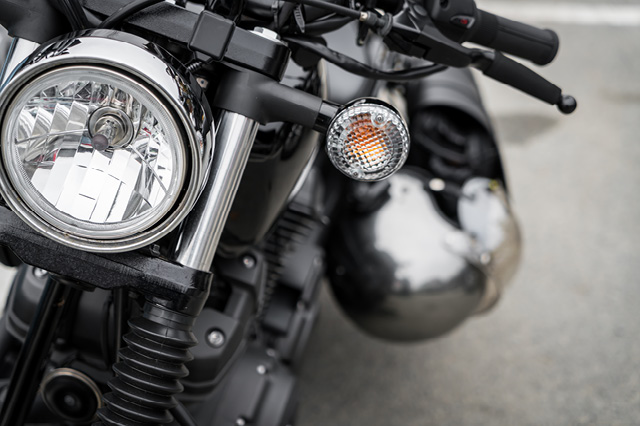With spring comes the sweet sound of rolling thunder (and we’re not talking about the weather!).
Motorcyclists itch for the first nice day of spring, when the sun is shining, the temperature hits above 60 degrees and the conditions are just right. Before that long-awaited ride, take care of spring motorcycle maintenance to get ready for the road.
Ready, Set, Go
When getting your bike out of winter storage, give it a fresh oil change and have a professional do a thorough inspection to check on the brakes, fluid levels, tire pressure, battery and other mechanics.
Once the big spring motorcycle maintenance items are taken care of, the Motorcycle Safety Foundation recommends a quick assessment before every ride. The acronym T-CLOCS reminds riders to look at their tires, controls, lights, oil, chassis and stands.
Insurance Basics
A specialized motorcycle insurance policy can provide full coverage for you and your bike.
Like car insurance, a minimum amount of liability coverage for bodily injury or property damage caused to others by you, is required in almost every state. Other types of coverage, like collision, which can help cover the cost of repairs if your bike is in a crash, and comprehensive, for damages from events such as fire, theft or vandalism, are usually optional.
The beauty of a specialty policy is that it can provide a wider range of customizations, a perk that any motorcycle owner can appreciate. Each policy is as unique as its rider. When requesting a quote, mention if your bike has any modifications, if you own a vintage model or have more than one bike, which will likely affect your coverage needs and premium. If you frequently carry passengers, you may also want to consider adding guest passenger liability.
Depending on state and provider, discounts are sometimes offered for multi-bike owners, mature riders, training course completion and memberships in rider associations or clubs. Check with your insurance agent to find out about the laws where you live, coverage options and available savings.
Learn more about motorcycle and scooter coverage through AAA Insurance.
At the Roadside
Whether it’s just a drive around the neighborhood or you’re headed all the way to Sturgis, no one wants their trip delayed by unexpected holdups. You should always be prepared to “shift gears” when needed. If you do find yourself stuck at the side of the road, pull over to a safe location and call roadside assistance for any repairs too significant to fix on your own.
AAA Plus and Premier members can sign up for motorcycle coverage for 24-hour roadside services including jumpstarts, tire inflation, fuel delivery and towing for all street-legal motor bikes. Roadside assistance is also included with motorcycle insurance policies acquired through AAA, so you can get the help you need and keep on riding.

Safety and Gear
Motorcyclists are five times more likely to be injured and 28 times as likely to be killed than car occupants, according to the most recent research by the National Traffic Safety Administration.
Don’t forget that motorcycles have different reaction times and are less visible to surrounding vehicles. Follow traffic laws, never drive impaired and always wear a U.S. Department of Transportation-compliant helmet and other protective gear.
Sharing the Road With Motorcycles
If you don’t own a motorcycle, you probably know someone that does. Keep their safety in mind when sharing the road, especially between May and September when riders are more likely to be out.
- “Look twice, save a life.” Check mirrors and blind spots for motorcycles before switching lanes and at intersections.
- Signal before changing lanes or merging and allow enough time to determine a motorcyclist’s intention before proceeding.
- Increase following distance and provide enough time to stop in an emergency.
There’s a camaraderie among motorcyclists that can often be seen by a passing wave or a cool thumbs up. An upside-down peace sign from one rider to another means to keep your two wheels on the ground. In other words, stay safe out there.
Get in touch with a AAA Insurance agent to find out about coverage options for your motorcycle, boat, RV or other leisure vehicle.
What are your spring motorcycle maintenance tips? Tell us in the comments.
5 Thoughts on “Spring Motorcycle Maintenance Checklist”
Leave A Comment
Comments are subject to moderation and may or may not be published at the editor’s discretion. Only comments that are relevant to the article and add value to the Your AAA community will be considered. Comments may be edited for clarity and length.















I like what Neil has to say also. I’d like to add something. I’m also a long time rider 51years. My big brother Ed taught me how to ride. When you approach an intersection, you may notice that a car on the cross-street may be still. Your eyes may be playing a trick on you, or the sun is in the background messing with your sight. If you question whether that car is moving or not always look at the front wheels. One more thing up here in the North East they like to use sand on the roads in the winter and it takes a little while before the street sweepers sweep it up. Beware of the sand. Always respect others on the road and respect your bike. My brother Ed use to say the second you don’t respect the bike it’s going to let you know about it.
Hi Ken.
Thanks for your reply. I too am a long term rider (54 years). Your comment about sand brought back memories. When I was a fairly new rider, I was leaning into a sharp turn at maybe 25 miles per hour when I unexpectedly hit gravel on the road. I slid on my side for about 20 feet before I came to a stop. That was the only time I ever dropped a bike. The lesson learned is to be observant when entering a blind curve. One other precaution that I learned early on. I was entering a toll booth on the George Washington Bridge. I hit an oil slick right at the beginning of the toll lane. I slid slightly to the left. The toll lane can get greasy from the leaks of idling cars and going straight down the middle of the lane can be hazardous. Later I called the Port Authority and they agreed to de-grease the lanes through the booths more often.
Hint to older riders: When you go to renew your license, don’t let the people at the DMV try to convince you that, at your age, you don’t need to keep that motorcycle part of your license anymore.
As a long time motorcycle rider, I know that the most dangerous place for motorcyclists is intersections. Sometimes when you approach an intersection, you may notice that the auto driver on the cross-street appears to be in a hurry, inching up into the intersection or may appear distracted. Knowing that a motorcycle is not as visible as a car, a short hit on your horn will make the driver aware of your presence. This has saved my life more than once. Remember, although most drivers respect motorcycles, there are some that don’t think that we have equal rights on the road.
If your bike is older and the headlights don’t automatically come on when you start the engine, then remember to turn them on. Anything you do to make yourself more visible increases your chance of arriving at your destination. Also. most people don’t think about their tail lights. Every time that you start up your bike an inspection of the lights (etc.) is imperative.
Hi Neil, thanks for adding these helpful tips! -MP
It’s always a pleasure to meet female riders on the road. Drive safely.
Neil